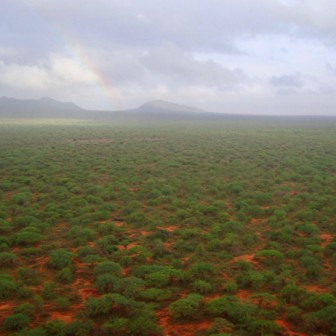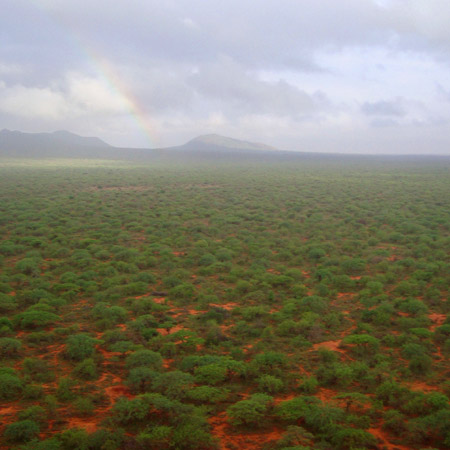WASHINGTON, -As U.N. talks keep failing to agree how to raise money to protect forests, private investors are testing a trade in credits to slow the deforestation that emits as much carbon as all the world’s cars, ships, trucks and planes.
French bank BNP Paribas is one of a handful of financial institutions and investment funds entering the risky but potentially lucrative market for REDD “credits” – units representing one tonne of carbon dioxide not emitted because a forest was left standing.
Last September, BNP’s commodities derivatives arm provided $50 million to Wildlife Works, a conservation project developer designing a portfolio of projects to reduce deforestation and degradation (REDD) in Africa.

In that deal, BNP also acquired the rights to buy up to 1.25 million carbon credits over the next five years from Wildlife Works’ flagship project in Kenya’s Kasigau corridor.
This scheme aims to protect over 500,000 acres (202,400 hectares) of forest, secure a wildlife migration corridor between two national parks and bring sustainable benefits to local communities through education, jobs for rangers, and an “ecofactory” to produce organic cotton clothing.
But such carbon credits have only found demand in a small, thinly traded voluntary carbon market, as countries struggle to agree new, binding emissions cuts under U.N. climate talks where acrimony lingers after the failed Copenhagen summit in 2009.
“There is growing impatience with the multilateral process, not only from practitioners such as myself, but more importantly, from many forest countries themselves,” said Christian del Valle, environmental markets and forestry director at BNP Paribas.
“Thus far the multilateral process has not delivered meaningful on-the-ground results, and forests continue to be lost because the only accessible price signal today indicates they are worth more cut down than standing,” added London-based del Valle, who is driving the bank’s investment in forest protection in Africa and Latin America.
A full U.N. climate deal could create a market through which rich polluting countries can buy carbon credits, paying for forest protection in the process, just as they pay for clean energy projects now under the Kyoto Protocol’s existing carbon offset market, the Clean Development Mechanism (CDM).
So far the only demand for forest carbon credits has been in the voluntary carbon market, worth $424 million last year, which lacks the binding rules that underpin the CDM.
Governments, such as Norway, Germany, Britain and the United States have pledged roughly $6.5 billion to help poorer countries develop systems to reduce emissions from deforestation, but that is seen only as a halfway house.
Private sector involvement will be essential.
Recent studies suggest that between $17 billion and $33 billion per year is needed to achieve a United Nations Environment Programme recommendation to halve global emissions from deforestation by 2030.
“We are not going to get the scale of what we need without participation by the private sector,” said Donna Lee, who served as the lead U.N. negotiator on REDD for the United States and is now a consultant for advisory group Climate Focus. “There is a disconnect between the understanding by countries and (UN) negotiators and the private sector of what the private sector needs in order to participate in REDD,” she said.
Lee said the U.N.’s climate change secretariat is not institutionally equipped for private sector participation or input.
Some negotiators view project developers and private investors as “carbon cowboys” responsible for the design of dubious carbon offset projects in developing countries under the present Clean Development Mechanism (CDM), she added.
One alternative to the so far futile attempts by the United Nations to achieve multilateral agreement among all its members may be bilateral or national action between two individual countries involving the private sector.
“It would be beautiful if everything could be done under the U.N. (climate change framework) but it is not. The success of the U.N. will likely be to ready REDD host countries to participate in emerging REDD market mechanisms but not to get global commitments out of developed countries,” said Leslie Durschinger, founder of Terra Global, which runs a private equity fund that raises project finance for REDD.
POCKETS OF DEMAND
She and other investors see pockets of demand emerging from national and regional carbon markets sprouting up across the globe.
Countries like Japan and Australia may allow their emitters to use REDD credits to comply with their proposed emissions trading schemes. And regulators in the state of California have said they may allow REDD credits from certain rainforest states and provinces abroad in their future carbon market from 2015.
“When you look beneath that surface layer you see the pieces that are there that will ultimately build the market for REDD. Slowly but surely you will see increased demand and successful and well-designed projects on the ground securing private capital,” Durschinger said.
Besides BNP, other early investors in these emerging markets include South Africa’s Nedbank Group , which provided an early multimillion dollar investment in the first phase of Wildlife Works’ Kenya project, to help meet the bank’s goal to become carbon neutral.
Australia’s Macquarie Bank announced this month it has raised $25 million to invest in forest carbon projects with the International Finance Corp. and a U.S. forest management firm.
Banking giant Bank of America Merrill Lynch is not yet directly investing in REDD but is partnering with a number of environmental non-governmental organisations (NGOs) developing REDD projects in China, Brazil, Indonesia and elsewhere.
Abyd Karmali, head of carbon markets at Bank of America Merrill Lynch , said his bank was merely “testing the waters” in its investment in REDD. He said reservations about investing in REDD boil down to a simple economic issue.
“Secure demand is all it would take to motivate more private sector interest,” he said.
To drive that demand it may be necessary to be more imaginative about how to sell forest conservation in private sector markets, moving beyond carbon credits to other, perhaps less tradable assets such as brands.
REDD offset deals that are taking place in the voluntary carbon market represent just a fraction of the private sector’s investment potential, said Benoit Bosquet, a lead carbon finance specialist at the World Bank.
“Right now what we understand is a sort of CDM-like offset system because we know the private sector has been involved in the CDM,” said Bosquet, who coordinates the bank’s fund that supports developing countries’ REDD readiness efforts.
“It would be very sad if private sector investments in REDD would be limited to the purchase of carbon offset credits.”
Companies in agriculture, energy, transport, tourism and mining — all of which may have a forest footprint — can identify opportunities at different stages of their production chains that investors can participate in. An example could be an agricultural company raising crops on already degraded land rather than clearing more forests.
“This full range of opportunities is nowhere near fully understood,” said Bosquet. “I think you are going to see different investors move into different segments of this range of opportunities – some that are quite keen to invest in REDD regardless of the carbon offset opportunities.”

